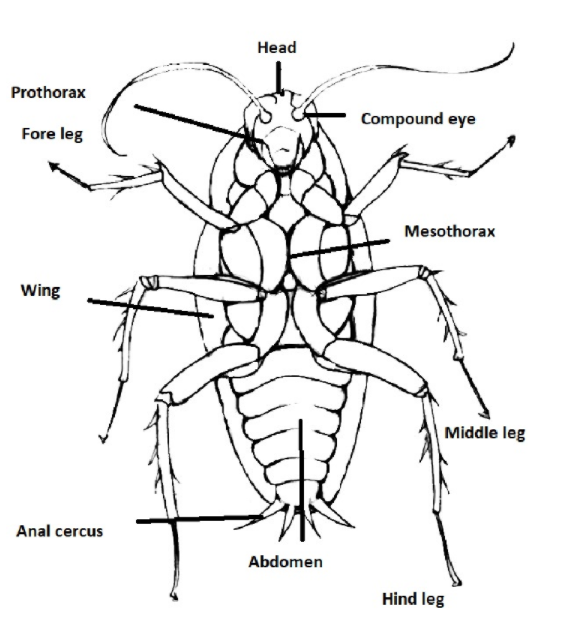
Describe the parts of the mouth of a cockroach.
Answer
553.8k+ views
Hint: Cockroaches are present from millions of years evolving into some of the most adaptable pests on Earth.
The body of cockroach is segmented and divisible into three different regions:
1. Head
2. Thorax
3. Abdomen
The whole body of cockroach is covered by a hard chitinous exoskeleton which is generally brown in color.
Complete answer:
Cockroach: They belong to a class of Insecta of Phylum Arthropoda.
Cockroaches are mainly brown or black bodied animals.
But in tropical regions, bright yellow, red, and green colored cockroaches are found.
Sizes range from 0.5 inches to 3 inches.
Anterior parts of the head bear appendages forming biting and chewing type of mouth parts.
The mouthparts of the cockroach include
1. Labrum
2. Mandibles
3. Maxillae
4. Labium.
Labrum or also known as the upper lip is a broad and roughly rectangular shaped structure.
It hangs from the front edge of the head on the lower side.
A tongue like structure is present in the floor of the mouth known as hypo pharynx.
Mandibles are a pair of hard, strong, large, dark colored structures found one on either side with ragged inner sides.
They move in horizontal motion and crush the food present in-between them.
Maxillae are a pair of structures which are present outside and behind the mandibles.
Each consists of three parts known as
1. Protopodite
2. Exopodite
3. Endopodite.
Labium is said to be formed by the fusion of the second pair of maxillae.
It forms the broad median lower lip and has a pair of 3-segmented labial palps on either side which is sensory in nature.

Note:
A cockroach's mouth can move from side to side and is capable of processing smell and taste simultaneously.
Cockroaches are also equipped with salivary glands and an esophagus, which assist in digestion.
At the base of the esophagus, food is temporarily located in the crop.
The body of cockroach is segmented and divisible into three different regions:
1. Head
2. Thorax
3. Abdomen
The whole body of cockroach is covered by a hard chitinous exoskeleton which is generally brown in color.
Complete answer:
Cockroach: They belong to a class of Insecta of Phylum Arthropoda.
Cockroaches are mainly brown or black bodied animals.
But in tropical regions, bright yellow, red, and green colored cockroaches are found.
Sizes range from 0.5 inches to 3 inches.
Anterior parts of the head bear appendages forming biting and chewing type of mouth parts.
The mouthparts of the cockroach include
1. Labrum
2. Mandibles
3. Maxillae
4. Labium.
Labrum or also known as the upper lip is a broad and roughly rectangular shaped structure.
It hangs from the front edge of the head on the lower side.
A tongue like structure is present in the floor of the mouth known as hypo pharynx.
Mandibles are a pair of hard, strong, large, dark colored structures found one on either side with ragged inner sides.
They move in horizontal motion and crush the food present in-between them.
Maxillae are a pair of structures which are present outside and behind the mandibles.
Each consists of three parts known as
1. Protopodite
2. Exopodite
3. Endopodite.
Labium is said to be formed by the fusion of the second pair of maxillae.
It forms the broad median lower lip and has a pair of 3-segmented labial palps on either side which is sensory in nature.

Note:
A cockroach's mouth can move from side to side and is capable of processing smell and taste simultaneously.
Cockroaches are also equipped with salivary glands and an esophagus, which assist in digestion.
At the base of the esophagus, food is temporarily located in the crop.
Recently Updated Pages
Master Class 12 Social Science: Engaging Questions & Answers for Success

Master Class 12 Physics: Engaging Questions & Answers for Success

Master Class 12 Maths: Engaging Questions & Answers for Success

Master Class 12 Economics: Engaging Questions & Answers for Success

Master Class 12 Chemistry: Engaging Questions & Answers for Success

Master Class 12 Business Studies: Engaging Questions & Answers for Success

Trending doubts
What are the major means of transport Explain each class 12 social science CBSE

Which are the Top 10 Largest Countries of the World?

Draw a labelled sketch of the human eye class 12 physics CBSE

How much time does it take to bleed after eating p class 12 biology CBSE

Explain sex determination in humans with line diag class 12 biology CBSE

Explain sex determination in humans with the help of class 12 biology CBSE




